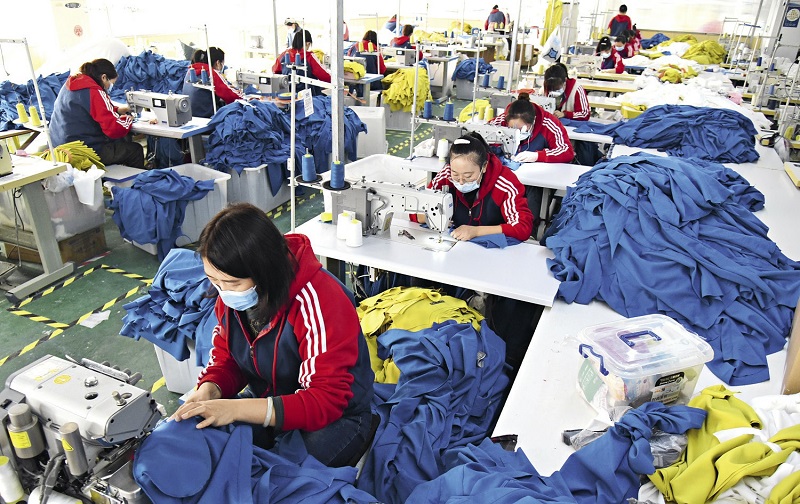“Some regions and some people may prosper before others do, and then they can help other regions and people to gradually do the same,” the late Chinese leader Deng Xiaoping told a U.S. business delegation on October 23, 1985.
With this idea of “allowing some regions and some people to prosper before others do,” China steered away from egalitarianism and broke free from the limitations of planned economy more than 40 years ago. Its reform and opening-up has since ignited the enthusiasm of all sectors of its society and supercharged economic development.

People relocated from Taizhou City to Lintou Village of Wenling City, Zhejiang Province are planting lettuce on October 17, 2021.
Common Prosperity, a Core Subject
Due to the dual sector model of economic development, uneven distribution of resources and other factors, strong economic growth and huge wealth created have also been accompanied by growing injustice and imbalance. Published data show that between 1978 and 2019, China’s Gini coefficient edged up from 0.317 to 0.465, peaking in 2008 at 0.491.
This imbalance is reflected in the income gap between urban and rural areas. The 2020 statistics communique on national economic and social development released by the National Bureau of Statistics shows that the average per capita disposable income of Chinese people last year stood at RMB 32,189, with the figure for urban residents being RMB 43,834 and that for rural residents RMB 17,131 – a glaring disparity.
The income divide between different regions and professions is also prominent. Earnings in industries such as Internet and finance are much higher than those in traditional labor-intensive sectors. This indicates China is yet to realize the goal of common prosperity.
The Chinese government has taken a slew of measures to address unjust wealth allocation and the income divide over the past 20 years, and marked progress has been made. The urban-rural income ratio contracted by 0.08 to 2.56 from 2019 to 2020, and the cross-regional income ratio dipped from 1.673 in 2015 to 1.64 in 2019.
“In general, income distribution has steadily improved, and per capita income has been increasing year by year, roughly in lockstep with economic growth. This is commendable. The major problem now confronting China is how to narrow the income gap between individual citizens, between different sectors of the economy and regions, and between cities and the countryside,” said Yang Yiyong, director of the Market and Price Institute at the Chinese Academy of Macroeconomic Research.
Reform and opening-up has led China to accomplish achievements that have amazed the world. Between 1985 and 2020, its economic aggregate surged 112-fold from RMB 901.6 billion to RMB 101.6 trillion, with per capita GDP reaching RMB 72,447 (US $10,504) in 2020. This has laid a solid economic foundation for China to realize common prosperity.
“China now reiterates the goal of common prosperity. This shows that the Communist Party of China (CPC) has stayed true to its founding mission and original aspiration, honored its promise as the governing party, and remains committed to the fundamental goals of socialist modernization. Seeking common prosperity is the requirement of the new phrase of China’s economic development, the desire of the people, and a demand of socialism and a people-centered development philosophy,” said Li Keaobo, executive director of the Institute for Chinese Economic Practice and Thinking, Tsinghua University.

Employees busy at work in a Chinese wolfberry processing plant in Zhongning County of Zhongwei City, Ningxia Hui Autonomous Region on June 19, 2021. The industry related to Chinese herbs has been thriving in the region during recent years, increasing the income of local residents.
Common Prosperity Is Not Egalitarianism
At its 10th meeting, the Central Committee for Financial and Economic Affairs defined common prosperity as a kind of prosperity for all and affluence in both material and cultural terms. It is different from egalitarianism and will be sought in a sequential manner.
In the view of Professor Fu Changbo with the School of Sociology, Beijing Normal University, the concept of common prosperity describes the sort of modernized society China envisions and is based on the ideal of a society that is widely accepted. “It must be emphasized that common prosperity is not to achieve prosperity instantaneously or to steal from the rich to give to the poor. Common prosperity is not egalitarianism; it is prosperity for all achieved through institutional arrangements,” Fu said.
But he cautioned, “It must be noted that under common prosperity, there will still be a certain degree of wealth gap, because appropriate incentives will remain necessary. Absolute parity could cause lack of drive among the people.”
“By common prosperity, China means to regulate extremely high incomes and eradicate illegal incomes in accordance with the law and relevant regulations, so that low-income groups can live life with dignity, and the variation in living standards stays within a reasonable scope, preventing a vast chasm emerging between the highest-earning and the lowest-earning families,” said Su Hainan, former director of the Labor and Wage Institute under the Ministry of Human Resources and Social Security and a researcher at the Chinese Association of Labor Science.
Yang Yiyong echoed this view by saying, “Common prosperity doesn’t mean robbing the rich to aid the poor, but high-earners should shoulder more responsibilities for its realization. Common prosperity is not egalitarianism – it allows for motivation and differentiation.”
Regulating Excessively High Income
Since 2012, when the CPC convened its 18th National Congress, the term “common prosperity” has appeared repeatedly in the documents of the central authorities. In October 2020, the fifth plenary session of the 19th CPC Central Committee set the goal of making notable and substantive progress in pursuing common prosperity for all Chinese people by 2035. It declared, “(China will) expand the size of middle-income groups, increase the earnings for the low-income group, adjust excessive incomes, and prohibit illicit incomes, to create an olive-shaped distribution structure wide at the middle and narrow at the ends.”
The proposal to expand the size of middle-income groups reflects the Chinese reality. Chinese economists divide the country’s population into five groups – low-income, lower-middle-income, middle-income, higher-middle-income, and high-income groups. In his research, economist Ren Zeping found that in 2014 the three middle groups, which account for 60 percent of the population, all registered more than 10 percent growth in their disposable incomes, which is higher than that of the other two groups and above the national average. This trend however reversed after 2017. During the 2017-2019 period, income growth for the three middle groups was 6.3 percent by average, compared with 9.3 percent for the low-income group, 7.9 percent for the high-income group, and 7.1 percent for the national average.
In Ren’s view, the stronger growth in the incomes of the low-income group is attributable to China’s poverty reduction efforts, but the widening income gap between the high-income and middle-income groups is cause for concern. To address this, the fifth plenary session of the 19th CPC Central Committee announced that China will better regulate and adjust high incomes, protect legitimate incomes in accordance with the law, properly adjust excessively high incomes, and encourage high-earning individuals and businesses to pay back to society.

Workers at a small garment factory located in Haizhou District of Lianyungang City, Jiangsu Province, are working on filling an order from abroad on November 4, 2021.
Taxation Reform Is a Priority
Reform of the taxation system is regarded as vital for solving problems in China’s income distribution and removing obstacles in its pursuit of common prosperity.
At its 10th meeting, the Central Committee for Financial and Economic Affairs decided that China should intensify the leverage of taxation, social security, and transfer payments, and make income regulation more targeted. Reform of the taxation system is prioritized in this regard.
“For all high-earners, individual income tax must be collected in full. Tax on income from transfer of property and capital gains should be adjusted based on the existing fixed rate of 20 percent. And more types of taxes should be introduced, including property tax, inheritance tax, and gift tax,” said Su Hainan.
Property tax has been launched on a trial basis in certain Chinese cities such as Shanghai and Chong-qing and will be extended nationwide sooner or later. In his article “Establishing Modern Fiscal and Taxation Systems,” Finance Minister Liu Kun wrote that active and prudent measures should be taken for legislation on property tax so that progress will be made in a step-by-step manner. As for inheritance tax and gift tax, Song Xiaowu, director of the academic committee of China Society of Economic Reform, believes that the conditions are ripe for China to levy them. He suggested studies to be conducted during the 2021-2025 period, saying that introduction of the two taxes can stimulate consumption.
The inheritance tax is collected in many countries around the world, and should be considered by China as well, said Fu Changbo. It is in the interests of the whole of society. “When the transfer of wealth between family members and friends exceeds a certain amount, it should be taxed. The introduction of gift tax is a necessity, and often comes in tandem with inheritance tax. For public interests, the tax threshold can be set at a higher level,” Fu said. He suggested a pilot program for inheritance tax to be initiated in certain regions before it is officially launched.
“Property tax has been added to the government agenda for the 2021-2025 period, and discussions on inheritance tax and gift tax are also underway. They will all help promote common prosperity,” confirmed Yang Yiyong.
Tertiary Distribution
Wealth distribution is a core issue for common prosperity. At its 10th meeting the Central Committee for Financial and Economic Affairs stressed that a proper balance should be struck between efficiency and fairness and that basic institutional arrangements should be made for coordination between primary, secondary, and tertiary distribution.
In primary distribution, income is shared according to the role of different factors of production in the system of the market economy and efficiency is prioritized. Labor-capital relationship is a key factor in primary distribution.
Su Hainan advocated for preventing high incomes in monopolistic industries during primary distribution, because such incomes usually come from capital and are not entitled to all people who work in these industries. He also called for building a fairer market environment so that primary distribution is based on both one’s work and factors of production.
The role of primary distribution is nevertheless limited. It can hardly bring down the Gini coefficient, an indicator of income divide. According to Cai Fang, former vice president of the Chinese Academy of Social Sciences and a member of the monetary policy committee of the People’s Bank of China, in OECD (Organization for Economic Co-operation and Development) countries, the Gini coefficient more often than not stays above 0.4 after the primary distribution, and sometimes exceeds 0.5. It falls below 0.4 and even 0.3 in the end because of taxation and transfer payments. Redistribution is therefore needed to achieve better income distribution.
Secondary distribution is the redistribution of wealth between different income groups that the government makes through taxation and fiscal spending by way of social security, public services, and subsidies. It is carried out post-production.
“China’s Gini coefficient shows little change after secondary distribution, which indicates the adjustment is insufficient. We therefore need to strengthen redistribution,” said Su Hainan.
At the 10th meeting of the Central Committee for Financial and Economic Affairs, tertiary distribution was raised as an effective method to achieve common prosperity. Following the fourth and fifth plenary sessions of the 19th CPC Central Committee, this idea came into the spotlight once again, signifying its elevation into a state strategy.
Tertiary distribution is a redistribution of social resources and wealth through voluntary acts of the high-income group, such as donations and assistance. A good supplement to the primary and secondary distribution, it helps narrow the social divide and make income distribution more reasonable.
Primary distribution is made by the invisible hand of the market and follows market mechanisms. Secondary distribution is made by the visible hand of the government, which devises the mechanisms and sets the goals for taxation, social security arrangements, or transfer payments. Tertiary distribution is based on voluntary acts motivated by tax reduction, and functions through the partnership between the government and the public.
Fu Changbo believes that charity is the primary method suitable for this sort of distribution. But the desire and capability for charitable activities of the public are yet to be fully tapped, and there are restrictions on the scope of such activities. He hence suggested policy and institutional changes concerning charitable programs, such as leadership, participation, incentives, supervision, and self-discipline.
According to Li Keaobo, the fundamental experience gained from Chinese socialism is the government and market pitting their strength in the same direction. This can also be applied to devising mechanisms for common prosperity. “To be specific, the government should set the course in pursuit for common prosperity, especially on such issues as market mechanism, taxation system, and labor. It can do so through legislation and other means. It also needs to introduce policies to encourage market entities to contribute to common prosperity.”
WANG HONGRU is a reporter with China Economic Weekly.